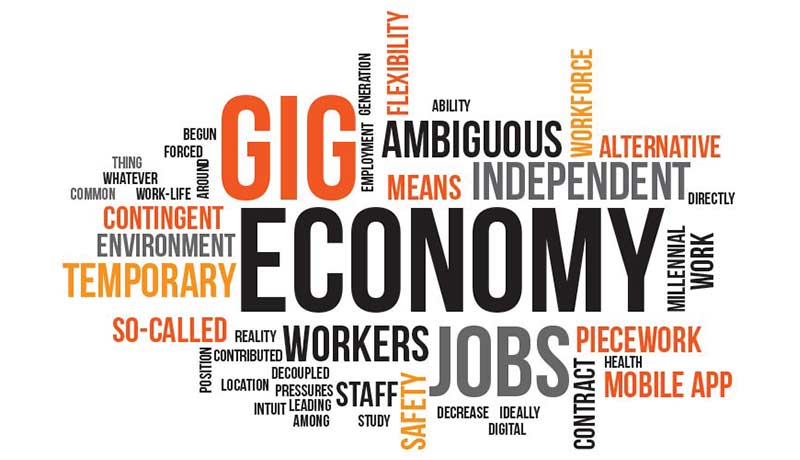
A gig economy is a dynamic market system governing with several free regulations in which temporary employment opportunities are widely common where firms recruit self-regulating workers for short-term tasks. The term “gig” is a slang word used for an activity that lasts for a limited period within the music party. Freelancers, independent contractors, project-based employees, and temporary or part-time hires may be examples of gig employees in the workforce.
The rise in short-term work has a variety of factors behind it. In the digital age, the workforce is becoming more mobile and work can increasingly be done from anywhere. As a result, job and location are being decoupled. This means that freelancers can select among temporary jobs and projects around the world, while employers can select the best individuals for specific projects from a larger pool than what’s available in any given area.
While all industries are evolving and changing, the tech and creative industries are the most vulnerable to the gig economy.
The Accenture Technology Vision 2017 report found that:
In fact, a recent survey commissioned by online freelancing platform ‘Upwork and Freelancers Union’ shows that the freelance workforce is growing three times faster than the overall US workforce and that the majority of people will be working independently by 2027.
Currently, the notion of a gig economy is actually nothing new. What was once known as autonomous contracting, freelancing, or flexible working now contains around 60 million US workers. During the years 2005-2015, the gig economy increased from 10.1 percent to 15.8 percent. By 2016, almost 1 in 4 Americans reported getting some money from the digital platform economy.
Digitization has also led directly to a decline in jobs as software replaces some types of work to maximize time efficiency. Other impacts include financial pressures on businesses leading to a flexible workforce and the entrance of the millennial generation into the labor market. Economic reasons also influence the development of a gig economy. Most times, employers cannot afford to hire full-time employees to do all the work they need to be done, so they hire part-time or temporary employees to take care of busier times or specific projects.

Lawrence Katz and Alan Krueger found in a research conducted in 2015 that nearly 16% of workers are engaged in “alternate work arrangements” of one kind or another. Another study in the year 2016 by the Freelancers Union, a non-profit organization in the United States of America provides advocacy, programming and curated insurance benefits for freelancers through partnerships and Upwork an American freelancing platform where enterprises and individuals connect in order to conduct business, estimated that 55 million Americans engage in some type of freelance work and that 54% of these workers have been paid for projects that they found and completed online.
JPMorgan Chase analysis of its checking account customers conducted in late 2015 estimated that 1% actively earn income from some type of online platform in a given month and that 4% had participated in one of these platforms over a three-year period.
Someone is considered a technology-enabled gig worker if they earned money in the last year from websites or mobile apps that connect sellers with buyers of a service, signed up online, and coordinated payments online. This definition was adapted from a conceptual framework developed by several researchers conducting ethnographic research on participants in various “crowd working” platforms. In addition to this type of gig work, the survey measured two other ways of earning money via digital platforms: home-sharing and online selling. Online gig work and home-sharing each fall under the Commerce Department’s definition of digital matching firms, but online selling does not. Many of these kind of surveys and studies designed to establish broad estimates of the share of Americans who have engaged in each of these money-earning behaviors in the recent past.
The other perfect example of exploring the growing trend in online freelance work is India. The gig economy in India has seen a big growth in recent years since Flipkart was the country’s only internet marketplace in 2010. Since then, the industry has been flooded with numerous digital channels, catering to services such as housework, cosmetics, and food delivery. The latest success stories in gig jobs are Swiggy and House of Joy.
The high-speed internet now reaches many of the first-world nations and is rapidly becoming visible internationally, work prospects are opening up outside a physical proximity beyond one’s local geographic region. Today, without even going around the organization they are working with, anybody can search, apply with, get a job and complete the assignments. Moreover, a gig worker can even get training, anywhere in the world that too in an adaptive training process, to specialize in just about any area of business they prefer. The internet has not only given us the power to find opportunities, but also the power to find and get training that is desirable for employers hence it is giving us chance to work from home bringing a new concept of home office and remote office.
Many freelancers, who make up the gig economy, know this and utilize the popular Pomodoro Technique to maximize their efficiency. With the Pomodoro Technique, you work in increments of 25 minutes on, five minutes off. That interval is one set, and every fourth set you take a longer break of 20 minutes.
Companies are constantly feeling the pressure of increased competition. This causes companies to squeeze every penny they can to maximize profits. In doing so, it is easier and cheaper for a company to hire a freelancer to work remotely without having the added costs of hiring and onboarding an employee. Freelancers don’t need office space, benefits, expense reimbursements or any of those other factors that employees require.
Many people think that freelancers are the ones who benefit most from the gig economy but in actual it is the companies that benefit the most. Other than the reasons stated above, companies get to select from a huge pool of candidates. Quality talent is the single biggest contributor to a company’s success. In the gig economy, instead of having access to talent in their geographic area, companies can now access highly specialized talent anywhere in the world.
And with the support of brilliant work management software, businesses can now handle these freelancers more effectively than ever before, due to new innovations in space.
Companies like Teamwork, Asana and Trello, to name a few, offer companies and freelancers the ability to manage tasks, priorities and timelines. While Upwork, GoLance and others allow companies to find the most skilled freelancers for their needs. With a task force of freelancers, companies now don’t need to neglect any project due to the lack of specialized employees in their payroll.

The days of a company defining how much an employee is worth are dwindling. A report by the Kauffman Index shows that 550,000 Americans start businesses every month and in doing so, they are starting their own businesses and side hustles to command their own salaries. A comfort to many employees is the convenience of a consistent paycheck while entrepreneurs and freelancers think differently. Now more than ever there is an opportunity for entrepreneurs and freelancers to take control of their income, and many are seizing that opportunity this is the best sustainable model in a time the remote working facilities increased and became systematic.
Gig economy workers often appreciate flexible job hours in addition to generating their own wealth and alternate income. In my opinion, we’ll see the number of 8-5 PM, Monday through Friday jobs decline because it’s now easier than ever to work whenever it’s convenient to do so. During the COVID-19 pandemic, lock-down period workers and organizers already experienced it.
As per my observations and experience, companies that embrace freelancers will be more flexible and will innovate faster. On the flip side, becoming a freelancer and commanding your own salary is now easier than ever before. With more than 50 million people now a part of the fast-growing gig economy, those companies that aren’t embracing gig workers will soon be left behind. We are exponentially growing to the big realities of an enormous gig economy so let’s harvest the best of it. Students and young career aspirants should utilize this golden opportunity of buffet employment with their own autonomy of pace, style and preferences.
